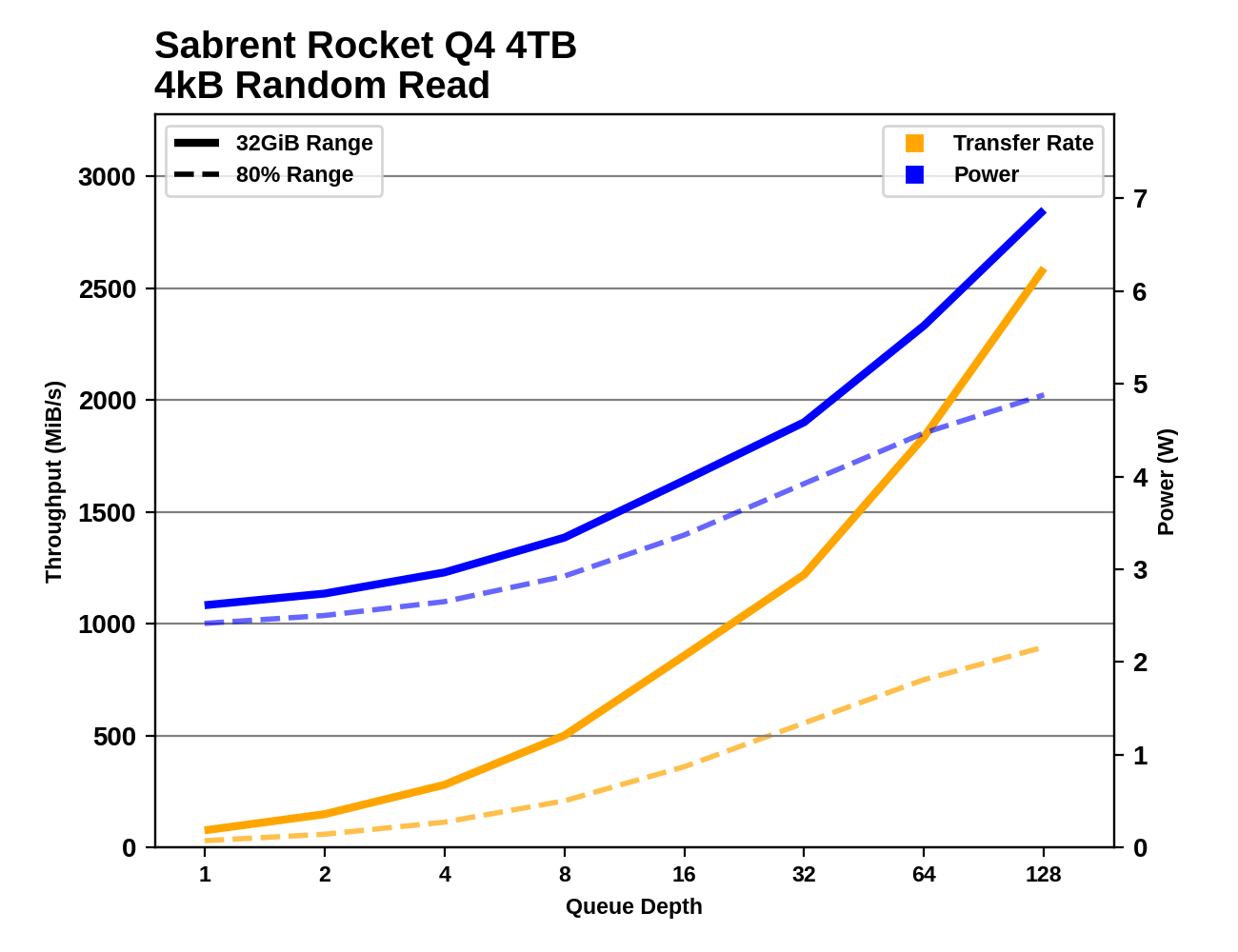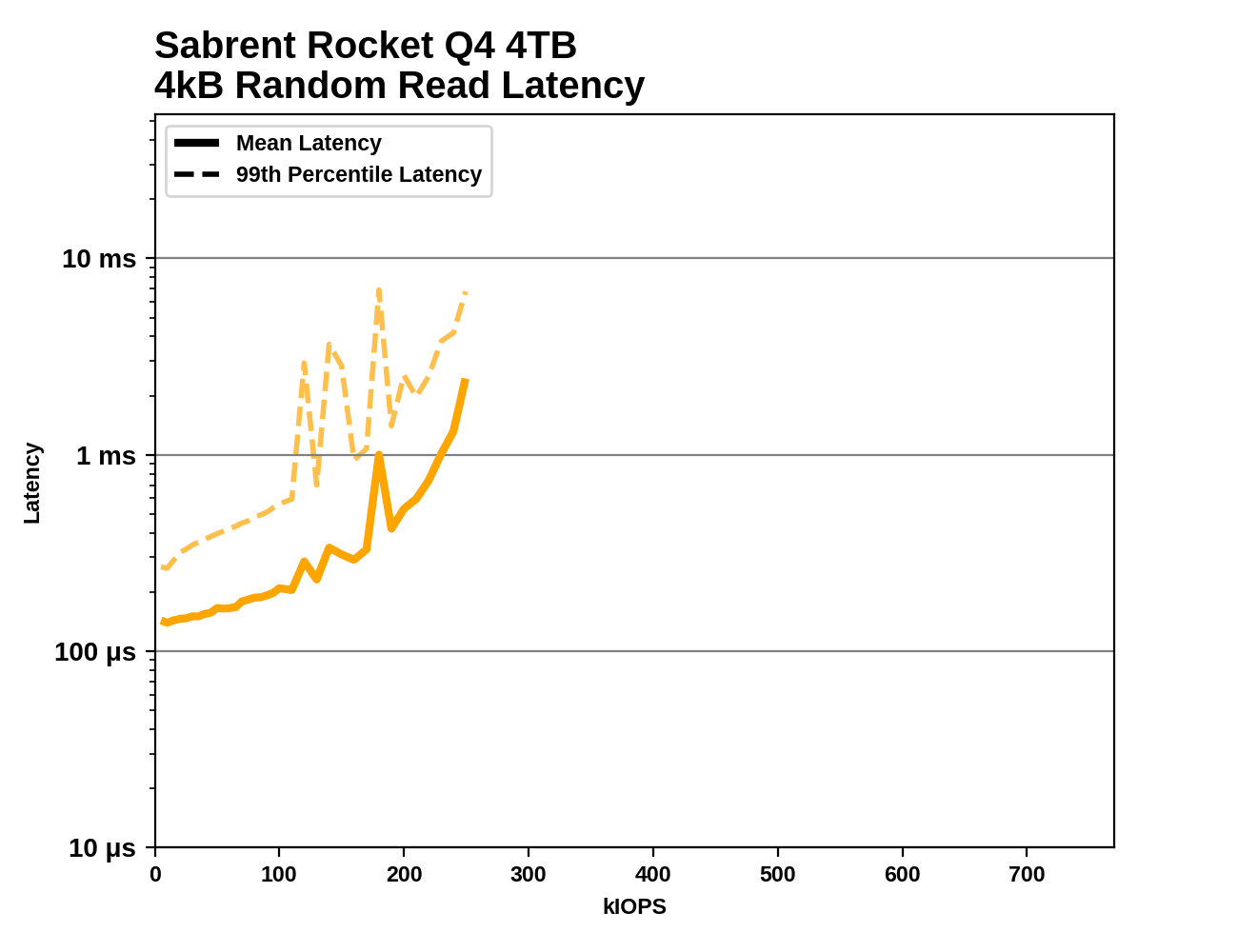Sabrent Rocket Q4 and Corsair MP600 CORE NVMe SSDs Reviewed: PCIe 4.0 with QLC
by Billy Tallis on April 9, 2021 12:45 PM ESTBurst IO Performance
Our burst IO tests operate at queue depth 1 and perform several short data transfers interspersed with idle time. The random read and write tests consist of 32 bursts of up to 64MB each. The sequential read and write tests use eight bursts of up to 128MB each. For more details, please see the overview of our 2021 Consumer SSD Benchmark Suite.
 |
|||||||||
| Random Read | Random Write | ||||||||
| Sequential Read | Sequential Write | ||||||||
The random read performance from the SLC caches on the Rocket Q4 and MP600 CORE are plenty fast, albeit still not able to match the Intel SSD 670p. Outside the cache, the two Phison E16 QLC drives are definitely slower than mainstream TLC drives, but their performance is fine by QLC standards.
For short bursts of writes that don't overflow the SLC cache, these drives are very fast and their caches are still useful even when the drive as a whole is 80% full.
As is often the case for Phison-based drives, the low queue depth sequential read performance is still not great, but sequential writes are very fast and do reach PCIe Gen4 speeds.
Sustained IO Performance
Our sustained IO tests exercise a range of queue depths and transfer more data than the burst IO tests, but still have limits to keep the duration somewhat realistic. The primary scores we report are focused on the low queue depths that make up the bulk of consumer storage workloads. For more details, please see the overview of our 2021 Consumer SSD Benchmark Suite.
 |
|||||||||
| Random Read | Throughput | Power | Efficiency | ||||||
| Random Write | Throughput | Power | Efficiency | ||||||
| Sequential Read | Throughput | Power | Efficiency | ||||||
| Sequential Write | Throughput | Power | Efficiency | ||||||
The random read performance from the Rocket Q4 and MP600 CORE is greatly improved over the earlier Phison E12 QLC SSDs, at least when the test is hitting a narrow slice of the drive that should be entirely within the SLC cache. Random and sequential write results are both decent given that these are in many ways still low-end drives. These two drives are large enough (and have enough SLC cache) to handle much larger bursts of writes than 1TB models, even when the drives are 80% full.
 |
|||||||||
| Random Read | |||||||||
| Random Write | |||||||||
| Sequential Read | |||||||||
| Sequential Write | |||||||||
The E16-based QLC drives are able to continue scaling up random read throughput (from the SLC cache, at least) long past the points where other QLC drives hit a performance wall. The 4TB Rocket Q4 scales better than the 2TB MP600 CORE, and by QD128 it is handling random reads at 2.5GB/s and still has headroom for more performance. For random writes, the Rocket Q4 and MP600 CORE saturate around QD4 or a bit later, which is fairly typical behavior.
When testing sequential reads, we get the characteristic behavior from Phison controllers: poor throughput until around QD16 or so, at which point there's enough data in flight at any given time to allow the SSD controller to stay properly busy. The sequential write results are messy since both drives run out of SLC cache frequently during this test, and that makes it hard to identify what the performance limits would be in more favorable conditions. But it appears that sequential write speed is saturating around QD2, and stays flat with increasing queue depth except when the caching troubles come up.
Random Read Latency
This test illustrates how drives with higher throughput don't always offer better IO latency and Quality of Service (QoS), and that latency often gets much worse when a drive is pushed to its limits. This test is more intense than real-world consumer workloads and the results can be a bit noisy, but large differences that show up clearly on a log scale plot are meaningful. For more details, please see the overview of our 2021 Consumer SSD Benchmark Suite.
 |
|||||||||
The Sabrent Rocket Q4 and Corsair MP660 CORE show better latency on this test than the other low-end NVMe drives, but all the mainstream TLC drives with DRAM have clear advantages. Even the Samsung 870 EVO has lower latency until it gets close to saturating the SATA link. Between the 2TB MP600 CORE and the 4TB Rocket Q4, the larger drive unsurprisingly can sustain higher random read throughput and its latency climbs more gradually, but the Rocket Q4 does have more transient latency spikes along the way.










60 Comments
View All Comments
pdegan2814 - Wednesday, April 14, 2021 - link
The endurance rating of the standard MP600 is exactly why I bought it as well. It blows most other SSDs out of the water in that regard. And it's more than fast enough for my needs.ozzuneoj86 - Friday, April 9, 2021 - link
All I get from any SSD review lately is that SK Hynix needs to release a Gen4 drive, since their Gen3 drive leads by a good margin in many tests already. Unless you need more than 1TB on a single drive, there's not much reason to go with anything but the P31 (or the 980 Pro if money is no object). Very high efficiency (less power is less heat), high performance, high consistency (empty vs full) and competitively low price. The only thing preventing me from getting a P31 myself is that I'm sure they'll put out a Gen4 version before long, and unless they screw something up it should be among the best drives available.ozzuneoj86 - Friday, April 9, 2021 - link
Sorry, I forgot about the SN850 and 970 Pro... those are also competitive, but much more expensive.bernstein - Saturday, April 10, 2021 - link
The problem with the p31 is that it was never available. at least in europe. And there is no 2tb model...ozzuneoj86 - Sunday, April 11, 2021 - link
Sorry to hear they are hard to get in Europe. The P31 is very easy to get in the US for $135 and often goes on sale for less at Amazon.But I agree, not having a 2TB option is unfortunate.
Samus - Sunday, April 11, 2021 - link
We can get the 1TB regularly for (MSRP?) $130-$135 at retail and online in the USA, but as you and ozzuneoj said, not having a 2TB variety is a missed opportunity for Hynix because this has been my go-to drive for nearly a year in just about every upgrade I do (I use nothing else in laptops or SFF\ITX systems where the power efficiency and low heat are most beneficial)On top of that, I have installed dozens and zero have failed. An amazing accomplishment from Hynix. I've used the S31 in legacy systems with SATA ports and it's equally excellent especially for the price, though the MX500 is still my go-to drive for legacy systems because it is often slightly cheaper, and again, I have seen zero failures from those drives over the years.
Come on Hynix make a 2TB model already...
back2future - Sunday, April 11, 2021 - link
that's not the point for data retention . Having data on a SSD (nand flash, type slc, mlc, tlc, qlc) it would be necessary specification for customers (beside TBW) how to store SSDs or power cycle for long term data security?While having been impressed with performance (compared to non-raid HDD) since first time SSD experience, few information about long term data security is minor customer support on that item?
Hulk - Friday, April 9, 2021 - link
I'm pleasantly surprised by the very good performance metrics for these drives. The combination of 1/4 drive SLC cache with the "housekeeping" in the background makes for a fast, yet economical drive. I have a feeling prices on these will drop pretty quickly and they'll be a great buy in 6 months to a year. I don't think I'd use them in a laptop and I think I'd go 2TB or larger for the sake of performance and endurance though.shabby - Friday, April 9, 2021 - link
Quality(endurance) , price, performance... choose two. With qlc you can only choose one 🙄Hulk - Friday, April 9, 2021 - link
I'm not so sure about that. 225GB day written for 5 years for the 2TB drive. If you aren't in a server situation I don't know how you'd ever get near that number.